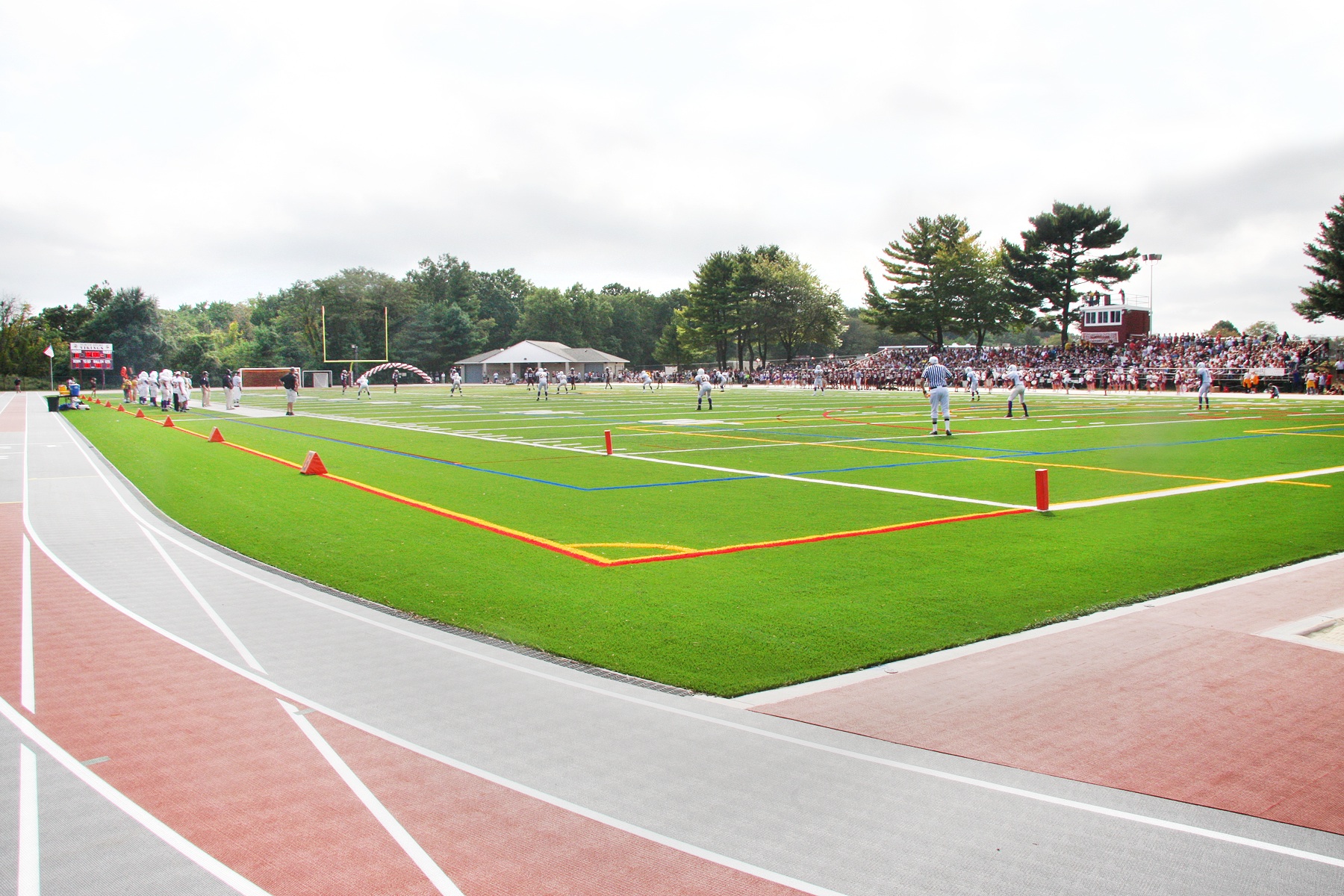The leadership of the North Shore School District, community leaders and BBS Architects, Landscape Architects and Engineers celebrated the official opening of the new athletic field, running track and supporting facilities.
The district encompasses a high school, middle school and three elementary schools. BBS served the district as architect and engineer for the project. Savin Engineers provided construction management services.
“The new, $3.8-million, 100,000-square-foot sports complex replaced and expanded the deteriorated facilities which were insufficient for the needs of the district’s 2,850 students,” says BBS Director of Architecture Joseph B. Rettig, AIA, LEED AP. “The new complex includes a multi-use, synthetic turf field; an eight-lane running track; and a 1,700-square-foot concession, bathroom and storage building.”
The creative financing for the project included a combination of the district’s private/not-for-profit and other public sources. This public/private combination of funding sources was unusual for a school-related construction project, but made financing easier at the time when local property tax increases in New York State are capped at 2%. The support of the Viking Foundation allowed the district to utilize funds raised through direct taxation to maintain the necessary level of instructional activities, while still making the construction of the new field and track possible.
The BBS team faced several engineering challenges, including the requirement to protect a neighboring wetland recharge basin and a poorly draining fill and soil at the site of the new field.
The complex also includes a new, one-story, multi-purpose building that serves as the main entry port to the athletic facilities. The building consists of two structures connected by a pitched steel truss roof with gray asphalt shingles and a reverse gable. The entryway between the buildings is protected by a decorative iron gate. The entire athletic facility received a new security system. +
Related Stories
| Nov 2, 2010
Energy Analysis No Longer a Luxury
Back in the halcyon days of 2006, energy analysis of building design and performance was a luxury. Sure, many forward-thinking AEC firms ran their designs through services such as Autodesk’s Green Building Studio and IES’s Virtual Environment, and some facility managers used Honeywell’s Energy Manager and other monitoring software. Today, however, knowing exactly how much energy your building will produce and use is survival of the fittest as energy costs and green design requirements demand precision.
| Nov 2, 2010
Yudelson: ‘If It Doesn’t Perform, It Can’t Be Green’
Jerry Yudelson, prolific author and veteran green building expert, challenges Building Teams to think big when it comes to controlling energy use and reducing carbon emissions in buildings.
| Nov 2, 2010
Historic changes to commercial building energy codes drive energy efficiency, emissions reductions
Revisions to the commercial section of the 2012 International Energy Conservation Code (IECC) represent the largest single-step efficiency increase in the history of the national, model energy. The changes mean that new and renovated buildings constructed in jurisdictions that follow the 2012 IECC will use 30% less energy than those built to current standards.
| Nov 1, 2010
Sustainable, mixed-income housing to revitalize community
The $41 million Arlington Grove mixed-use development in St. Louis is viewed as a major step in revitalizing the community. Developed by McCormack Baron Salazar with KAI Design & Build (architect, MEP, GC), the project will add 112 new and renovated mixed-income rental units (market rate, low-income, and public housing) totaling 162,000 sf, plus 5,000 sf of commercial/retail space.
| Nov 1, 2010
John Pearce: First thing I tell designers: Do your homework!
John Pearce, FAIA, University Architect at Duke University, Durham, N.C., tells BD+C’s Robert Cassidy about the school’s construction plans and sustainability efforts, how to land work at Duke, and why he’s proceeding with caution when it comes to BIM.
| Nov 1, 2010
Vancouver’s former Olympic Village shoots for Gold
The first tenants of the Millennium Water development in Vancouver, B.C., were Olympic athletes competing in the 2010 Winter Games. Now the former Olympic Village, located on a 17-acre brownfield site, is being transformed into a residential neighborhood targeting LEED ND Gold. The buildings are expected to consume 30-70% less energy than comparable structures.
| Oct 27, 2010
Grid-neutral education complex to serve students, community
MVE Institutional designed the Downtown Educational Complex in Oakland, Calif., to serve as an educational facility, community center, and grid-neutral green building. The 123,000-sf complex, now under construction on a 5.5-acre site in the city’s Lake Merritt neighborhood, will be built in two phases, the first expected to be completed in spring 2012 and the second in fall 2014.
| Oct 21, 2010
GSA confirms new LEED Gold requirement
The General Services Administration has increased its sustainability requirements and now mandates LEED Gold for its projects.
| Oct 18, 2010
World’s first zero-carbon city on track in Abu Dhabi
Masdar City, the world’s only zero-carbon city, is on track to be built in Abu Dhabi, with completion expected as early as 2020. Foster + Partners developed the $22 billion city’s master plan, with Adrian Smith + Gordon Gill Architecture, Aedas, and Lava Architects designing buildings for the project’s first phase, which is on track to be ready for occupancy by 2015.














